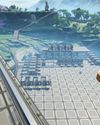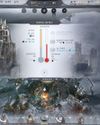The hidden tricks bringing game worlds to life.

Indie studio National Insecurities was well on its way to completing its latest first-person murder mystery parody, 2000:1: A Space Felony. It had an eye-catching name, a publisher, and a rock-solid visual and thematic base it could use to play off audience expectations. There was just one problem: The centrifuge didn’t work.
An astronaut jogs around a stark centrifuge, punching the air as he travels in an endless loop. This scene, from 2001: A Space Odyssey, is one of the most iconic in film history. And National Insecurities’ parody couldn’t replicate it. No matter what it did, the team couldn’t find a reliable, smooth way for the player to run along the centrifuge as it spiralled through space. Then lead developer, Lauren Filby had an idea.
Rather than attempting to create a special case for the player to be able to travel around the centrifuge while it was moving, she bent space around the player. When the player was outside the centrifuge, it would rotate as normal. However, as soon as the player entered the centrifuge, everything else in the game world would begin to rotate to ensure consistency of movement. This leap of logic is common to game development. Surprising in its requirements, bewildering in its utilization, and essential to increasing the fidelity of a game’s world.
KEEPING UP APPEARANCES
This story is from the {{IssueName}} edition of {{MagazineName}}.
Start your 7-day Magzter GOLD free trial to access thousands of curated premium stories, and 9,000+ magazines and newspapers.
Already a subscriber ? Sign In
This story is from the {{IssueName}} edition of {{MagazineName}}.
Start your 7-day Magzter GOLD free trial to access thousands of curated premium stories, and 9,000+ magazines and newspapers.
Already a subscriber? Sign In

"The War Within itself has kept me coming back most evenings too"
WORLD OF WARCRAFT remains my jailer, and I couldn't be more pleased about it

OK BUILDER
SATISFACTORY is the new titan in building and crafting games

HELL YES
DIABLO IV: VESSEL OF HATRED is a transformative expansion

MOUSE: PI FOR HIRE
This mouse wants to be more than just a gimmick

WINDBLOWN
Dead Cells dev's new roguelike has me afraid for my free time

NO MORE ROOM IN HELL 2
As the zombie horde surrounded me just moments after taking down my two remaining teammates, the writing was really on the wall. Armed with just a chef's knife, it was clear I stood no chance, but I was going down swinging, hoping for a miracle... it didn't come.

OWNED BY STEAM
VALVE cordially reminds you that your games aren't yours

CURSE OF THE AZURE BONDS
These classic games haven't aged badly, but I sure have.

DEEP FREEZE
Endure a blizzard of tough choices and rough consequences in FROSTPUNK 2

NEW HORIZONS
Building up REMNANT 2 outside the live service game grinder